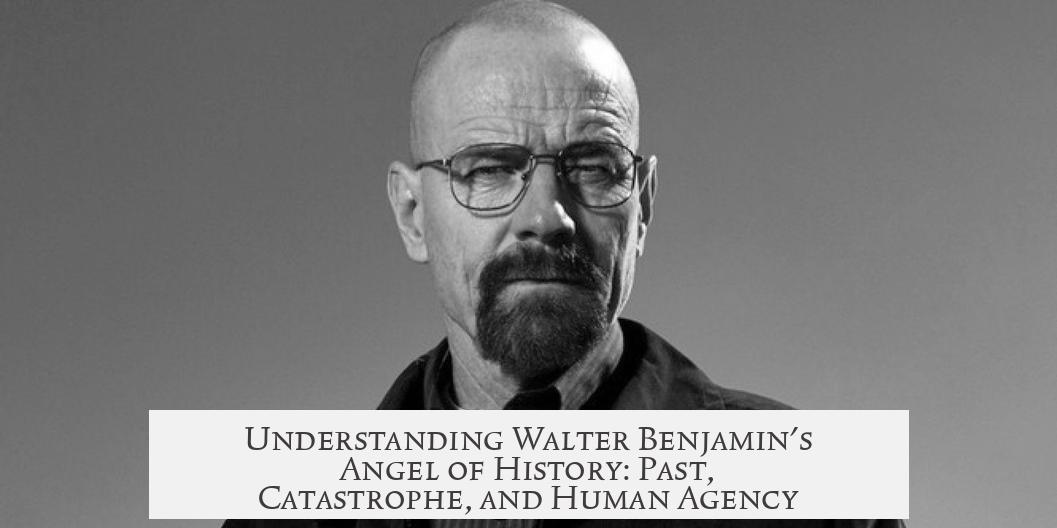Walter Benjamin’s Angel of History symbolizes a profound view of history as a relentless accumulation of catastrophe, seen through the angel’s backward gaze while its body is propelled forward by the winds of progress. This figure embodies the tension between human hope for redemption and the sorrow of historical devastation.

Benjamin introduces the Angel of History in “Theses on the Philosophy of History” (1940), specifically in thesis IX. The image draws from a 1920 painting by Paul Klee called Angelus Novus, which Benjamin interprets as an angel witnessing the wreckage of the past. The angel is caught mid-motion: its face looks backward toward history’s disasters, but an unstoppable storm pushes it into the future. This storm represents the idea of historic progress, ironically propelled over the ruins it leaves behind.
This metaphor arises in the bleak context of Benjamin’s own time, amid the rise of Nazism and World War II. He writes as a Jewish intellectual forced to flee Europe. His vision reflects not only the contemporary horrors but also a broader interpretation of history as a series of ongoing catastrophes rather than steady advances. History is not a straight line of progress but a catalogue of destruction that the Angel of History mourns while being driven forward.

The angel’s backward gaze shows a critical, non-dialectical perspective. Unlike the Enlightenment idea that history moves forward through reason and improvement, Benjamin’s angel sees progress as a form of destruction. Each new “advance” piles new wreckage on top of past tragedies. This view challenges optimistic narratives, highlighting the tragic human cost beneath historic change.
Benjamin also infuses the image with theological and ethical depth. The angel’s inability to stop reflects a messianic tension. According to Benjamin’s kabbalistic-Jewish inspiration, humanity is fallen and owes the world redemption. History’s suffering accumulates guilt, making each generation responsible in a spiritual sense. Humans bear a “weak Messianic power,” the potential to redeem past wrongs but limited by history’s amassed ruin. This tension between guilt and hope pervades Benjamin’s concept of history.

Benjamin’s Angel of History critiques not only the destructive trajectory of political regimes like Nazism but also the idea of unavoidable, linear progress. It underscores how history’s march carries unspeakable losses, continuously overlooked or forgotten. The angel’s sorrow is profound yet mixed with hope, envisioning the possibility that redemptive transformation may arise through the recognition of this wreckage.
This image departs from simple political or historical analysis. Benjamin intertwines aesthetics, theology, and ethics. The angel engages history on several levels:

- As an observer of constant catastrophe, not just specific events.
- As a symbol of humanity’s collective guilt and responsibility.
- As a bearer of limited messianic potential for redemption.
- As a critique of historicism and Enlightenment progress.
Hannah Arendt clarifies this by noting the angel’s undialectical stance: it does not move logically toward a future but faces the past’s unresolved devastation. Benjamin’s image thus embodies the contradictions of history—sorrowful due to its tragedy but containing a glimmer of hope through potential redemption.
Some key points in understanding Benjamin’s Angel of History:

| Aspect | Explanation |
|---|---|
| Direction | The angel faces backward, witnessing accumulated catastrophe, while being forced forward by progress. |
| Catastrophe | History seen as continuous destruction, not linear improvement. |
| Theology | Jewish kabbalistic motif; humanity’s fall, guilt, and weak messianic hope for redemption. |
| Political Critique | A condemnation of 20th-century totalitarianism and historical failures. |
| Dialectical Tension | Contradiction between hope for salvation and acknowledgment of irreversible loss. |
The angel’s image remains influential in philosophy, history, and cultural theory. It urges critical reflection on how history unfolds, prompting awareness of what is lost amid so-called progress. Benjamin neither rejects history nor embraces naive optimism. Instead, he offers a nuanced vision that compels acknowledgment of tragedy while holding on to a faint, yet persistent, hope for redemption.
- The Angel of History witnesses history as a chain of wreckage, sorrowful yet unable to halt progress.
- The backward gaze symbolizes a critique of linear, optimistic historicism.
- History carries collective guilt, demanding ethical reflection and weak messianic hope.
- Benjamin’s metaphor emerges from the context of Nazi persecution and European catastrophe.
- The angel balances despair and hope, exposing history’s human cost behind progress narratives.
Can Someone Explain Walter Benjamin’s Angel of History?

Walter Benjamin’s angel of history is a powerful metaphor portraying history as a relentless sequence of catastrophes that pile up like wreckage behind us, while the angel—facing backward—wishes to stop this destructive storm but is helpless, swept forward by the winds of progress. This image, both poetic and chilling, resides at the heart of his 1940 essay, Theses on the Philosophy of History (Über den Begriff der Geschichte).
But why does this angel look backward? What storms is it facing? And what does this mean in the dark shadow of World War II? Let’s dive deep — no angelic wings required.

1. The Origin Story: A Dark Time and a Complex Text
Benjamin wrote this during a grim chapter in history. In 1940, fleeing the Nazis, a Jewish German intellectual found himself trapped by unfolding catastrophe. This shadow colors the angel’s story. His Theses on the Philosophy of History are a set of 18 dense, interlinked meditations. Thesis IX launches us into the angel’s vision—deeply layered with theology, ethics, politics, and aesthetics.
Imagine existential dread paired with sharp political critique and a surreal art piece. The angel of history is Benjamin’s way of wrestling with the “wreckage upon wreckage” of human progress.
2. The Angel’s Eyes: Facing the Past, Not the Future
Here’s the twist: The angel doesn’t gaze ahead as most progress metaphors do. Instead, it stares back at history as if hypnotized by the past’s turmoil, unable to move forward unburdened. Hannah Arendt, a philosopher who admired Benjamin, points out this “undialectic” stance—meaning the angel rejects movement toward a hopeful future, fixated on the chaos left behind.
This image flips the usual view of history on its head. It’s as if the angel wants to learn from catastrophe but is trapped by it.
3. The Storm of History: Catastrophe After Catastrophe
The “storm” that propels the angel is history itself—far from a smooth journey of progress or improvement. Each step forward breaks something else, creating continuous disaster. The angel’s wings catch this storm, pushing it incessantly forward despite its plea to pause and mend. It wishes to repair wreckage but can only watch it accumulate.
Benjamin saw this pattern not just in WWII Europe but throughout history. Every “progress” contains its own trail of destruction and loss. This sober view critiques the 19th-century idea that humanity marches steadily toward a brighter future.
4. Theology, Guilt, and Redemption: The Religious Angle
Benjamin’s imagery draws deeply from his Jewish background and kabbalistic theology. The angel represents humanity’s condition after a fall from Paradise—a state where understanding and redemption are yet to be achieved.
Benjamin states pointedly, “The highest category of world history… is guilt.” History is not just a timeline but a ledger of accumulated human failings and injustices. Yet, embedded in this is a thread of messianic hope—that each generation carries a weak power to redeem the past.
Think of it this way: It’s like carrying a fragile but persistent flame in a very dark tunnel. The angel embodies both the weight of guilt and the faint possibility that salvation might emerge.
5. The Weak Messianic Power: Human Agency in a Relentless History
Benjamin doesn’t leave us in despair. He argues that there is a secret pact between past and present generations, endowing the alive with a “weak Messianic power.” This subtle notion means current generations hold some ability to undo or redeem previous catastrophes, even if they’re powerless to stop the historical storm entirely.
This is not blind optimism. It’s a modest hope — the recognition that while history piles on destruction, we retain some capacity for moral intervention. It’s an honest, tangible call to responsibility.
6. The Angel as a Critique of Politics and Time
Benjamin also critiques the politics of his day, particularly the failures of social democracy and the rise of totalitarianism. His angel is not just a figure watching history’s disasters; it questions the systems and powers that make such destruction possible. History, viewed through this lens, is not purely mechanical or inevitable—it’s deeply political and ethical.
His angel halts the notion that history is a straightforward march of progress. History instead is complex, uneven, and tragic.
7. Balancing Sorrow and Hope: The Angel’s Dual Nature
The angel of history captures a tension between despair and hope. Yes, the past is “wreckage upon wreckage.” Yet beneath the sorrow lies a glimmer of redemption. It’s a mixed message: progress involves loss, but within loss, there is still room for change.
This contrasts with Enlightenment optimism, which saw history as a ladder upwards. Benjamin reminds us to notice the ruins lying beneath each step.
8. Why Should We Care About This Angel Today?
This angel offers a perspective highly relevant now—amid climate crises, global crises, and political upheavals. Are our “progress” and technological flights clouding over the wreckage we leave behind? How do societies bear the burden of history’s disasters? How much are we willing to face the past honestly to build a better future?
The angel asks us to look back, acknowledge the damage, and not pretend forward motion erases tragedy. It’s a call to humility, action, and remembrance.
9. Practical Takeaways: Applying Benjamin’s Angel
- Historical Awareness: When studying history or current events, remember the hidden costs behind apparent progress.
- Moral Responsibility: Acknowledge the “guilt” collective societies inherit and seek ways to address wrongs instead of ignoring them.
- Critical Politics: Question narratives that glorify linear progress without acknowledging past wreckage, especially in education and media.
- Personal Reflection: Accept that personal and societal growth often involves recognizing failure and damage, not just celebrating achievement.
10. Final Thoughts: The Angel as a Timeless Symbol
Walter Benjamin’s angel of history remains a haunting and vital figure. It fuses theology, politics, and philosophy in a literary metaphor rich with meaning. It forces readers to wrestle with uncomfortable truths about progress, memory, guilt, and hope.
This angel doesn’t offer easy answers. Instead, it stands as a reminder that to truly understand history, one must face the storm, acknowledge the wreckage, and keep a fragile flame of redemption alive.
How might you turn your face from the future to look honestly at the past?



